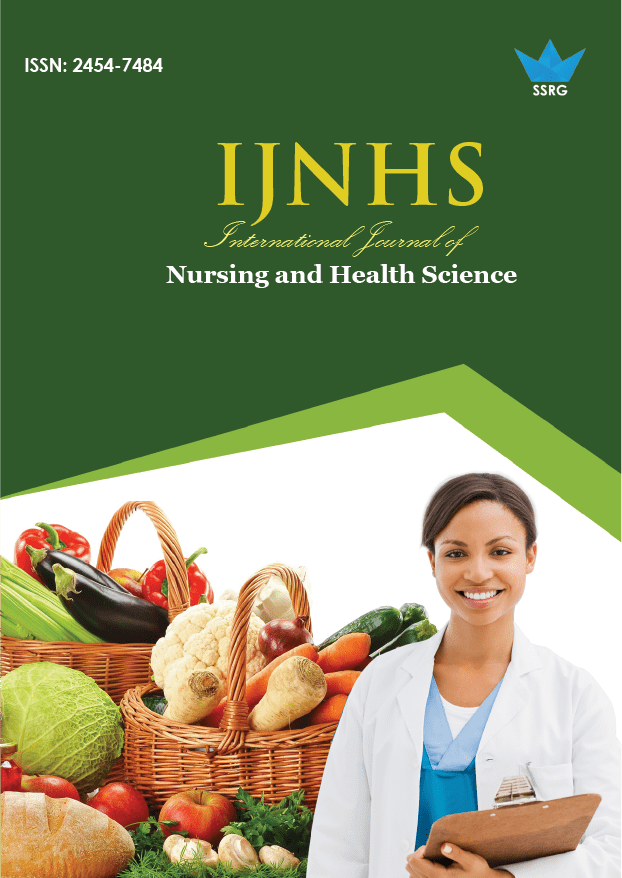Psychometric Properties (Validity and Reliability) of the Arabic Version of the Preterm Infant Feeding Survey (PIFS) Instrument

| International Journal of Nursing and Health Science |
| © 2020 by SSRG - IJNHS Journal |
| Volume 6 Issue 2 |
| Year of Publication : 2020 |
| Authors : Amel Abouelfettoh, Assma Mahfouz |
How to Cite?
Amel Abouelfettoh, Assma Mahfouz, "Psychometric Properties (Validity and Reliability) of the Arabic Version of the Preterm Infant Feeding Survey (PIFS) Instrument," SSRG International Journal of Nursing and Health Science, vol. 6, no. 2, pp. 9-14, 2020. Crossref, https://doi.org/10.14445/24547484/IJNHS-V6I2P103
Abstract:
The current study examines the validity and reliability of the Arabic version of the Preterm Infant Feeding Survey (PIFS) instrument. The original instrument was developed based on the Breastfeeding Attrition Scale and demonstrated adequate reliability and validity. Cross-culture validation was performed in three phases: Forward-Backward translation, pilot testing, and estimation of reliability and validity. A sample of 200 mothers and their preterm newborn infants were recruited from NICU at a tertiary level teaching hospital. Cronbach's α coefficient was calculated (Reliability). Factor analysis was used for the construct validity, and Principal Component Analysis and Varimax Rotation method were used for analyzing the factor structures. The final translated instrument included 70 items. Reliability for the Arabic PIFS instrument Cronbach's alpha was 0.895, with the Individual subscale's Cronbach alpha values ranged from 0.857 to 0.945. Factor analysis demonstrated 55 items in the 5-factor solution; these factors explained 54.85% of the variance. In conclusion, the Arabic-translated PIFS instrument showed satisfactory internal consistency and proved to be a valid and reliable tool that can be used to assess the factors contributing to maternal decision to breastfeed or not among mothers of preterm infants in Arabic-speaking populations.
Keywords:
Infant Feeding Survey, Instrument, Validity, Reliability.
References:
[1] Ochoa TJ, Pezo A, Cruz K, Chea-Woo E., Cleary T.G. Clinical studies of lactoferrin in children. Biochemistry and Cell Biology, 90(3) (2012) 457-467. http://doi10.1139/o11-087
[2] Woo J. G., Guerrero, M. L., Guo F., Martin L. J., Davidson B. S., Ortega H., et al., Human milk adiponectin affects infant weight trajectory during the second year of life, Journal of Pediatric Gastroenterology and Nutrition 2012; 54(4): 532-539. http://doi10.1097/MPG.0b013e31823fde04.
[3] Mwiru RS, Spiegelman D, Duggan C, Peterson K, Liu E, Msamanga G. et al., Relationship of exclusive breastfeeding to infections and growth of Tanzanian children born to HIV-infected women, Public Health Nutrition, 14(7) (2011) 1251-1258. doi:10.1017/S136898001000306X .
[4] Hair AB, Peluso AM, Hawthorne KM, et al., Beyond Necrotizing Enterocolitis Prevention: Improving Outcomes with an Exclusive Human Milk-Based Diet. Breastfeed Med, 11(2) (2016) 70‐74. doi:10.1089/bfm.2015.0134
[5] United Nations International Children’s Emergency Fund, UNICEF (2016). http://www.unicef.org/programme/breastfeeding/innocenti.htm
[6] Healthy People 2020. Department of Health and Human Services, Office of Disease Prevention and Health Promotion https://www.healthypeople.gov/2020/topics-objectives/topic/maternal-infant-and-child-health/objectives
[7] Bora R., Breast Feeding in Developing Countries: Is There a Scope for Improvement, Journal of Neonatal Biology, 5(1) (2016). doi:10.4172/2167-0897.1000208.
[8] Mgongo M, HusseinT H. Pedersen BS, Vangen S, Msuya S E, Wandel M., Facilitators and Barriers to Breastfeeding and Exclusive Breastfeeding in Kilimanjaro Region, Tanzania: A Qualitative Study, International Journal of Pediatrics, (2019) 7.Article ID 8651010, https://doi.org/10.1155/2019/8651010 [9] Lee SY, Jang GJ., Prevalence and Predictors of Exclusive Breastfeeding in Late Preterm Infants at 12 Weeks, Child Health Nursing Research, 22(2) (2016) 79-86. http://dx.doi.org/10.4094/chnr.2016.22.2.79
[10] Alves E, Rodrigues C, Fraga S, Barros H, Silva S., Parents’ views on factors that help or hinder breast milk supply in neonatal care units: a systematic review, Archives of Disease in Childhood-Fetal and Neonatal Edition, fetal neonatal-2013. DOI: 10.1136/arch dis child-2013-304029
[11] Dowling D A, Shapiro J, Burant C J, Elfettoh A., Factors influencing feeding decisions of black and white mothers of preterm infants, Journal of Obstetric, Gynecologic, & Neonatal Nursing, 38(3) (2009) 300-309. https://doi.org/10.1111/j.1552-6909.2009.01018.x
[12] Gray J R, Grove, S K, Sutherland S., Burns and Grove's The Practice of Nursing Research: Appraisal, Synthesis, and Generation of Evidence, Elsevier Health Sciences, (2017). 8th edition. New York: Saunders.
[13] Janke J., Development of the Breast Feeding Attrition Prediction Tool, Nursing Research, 43(2) (1994) 100–104.
[14] IBM Corp., IBM SPSS Statistics for Windows, Version 20.0. Armonk, NY: IBM Corp, (2011).
[15] Fabrigar LR, Wegener DT, MacCallum RC, Strahan EJ. Evaluating the use of exploratory factor analysis in psychological research., Psychological Methods, 493 (1999) 272 – 299. https://doi.org/10.1007/s10803-009-0816-2
[16] Lewandowski AJ, Lamata P, Francis JM, et al., Breast Milk Consumption in Preterm Neonates and Cardiac Shape in Adulthood, Pediatrics, 138(1) (2016) e20160050. DOI:10.1542/peds.2016-0050
[17] Mahajan HK., Two Criteria for Good Measurements in Research: Validity and Reliability, Annals of Spiru Haret University, 17(4) (2017) 56-82.
[18] Nunnally J, Bernstein I. (Eds.), Psychometric theory (3rd ed.). New York: McGraw-Hill, (1994).
[19] Kang NM, Choi YJ, Hyun T, Lee JE., Associations of Breastfeeding Knowledge, Attitude, and Interest with Breastfeeding Duration: A Cross-sectional Web-based Study, Journal of Korean Academy of Nursing, 45(3) (2015) 449-458. DOI: 10.4040/jkan.2015.45.3.449
[20] Husebye ES, Kleven IA, Kroken LK, Torsvik IK, Haaland OA, Markestad T., Targeted program for the provision of mother's milk to very low birth weight infants, Pediatrics, 134(2) (2014) e489–e495. https://doi.org/10.1542/peds.2013-2463
[21] Tengku Ismail TA, Wan Muda WA, Bakar MI., The extended Theory of Planned Behavior explains exclusive breastfeeding intention and behavior among women in Kelantan, Malaysia. Nutrition research and practice, 10(1) (2016) 49–55. https://doi.org/10.4162/nrp.2016.10.1.49
[22] Heidari Z, Keshvari M, Kohan Sh., Breastfeeding Promotion, Challenges, and Barriers: Qualitative Research., Int J Pediatr 4(5) (2016) 1687-95. https:// ijp.mums.ac.ir
[23] Khresheh RM, Ahmad NM,Breastfeeding self-efficacy among pregnant women in Saudi Arabia, Saudi medical journal, 39(11) (2018) 1116–1122. https://doi.org/10.15537/smj.2018.11.23437
[24] Gianni ML, Bezze EN, Sannino P. et al., Maternal views on facilitators of and barriers to breastfeeding preterm infants. BMC Pediatrics, 18 (2018) 283 https://doi.org/10.1186/s12887-018-1260-2
[25] Visuthranukul C, Abrams SA, Hawthorne KM, Hagan JL, Hair AB., Premature small for gestational age infants fed an exclusive human milk-based diet achieve catch-up growth without metabolic consequences at 2 years of age, Arch Dis Child Fetal Neonatal Ed, 104(3) (2019) F242‐F247. doi:10.1136/arch dis child-2017-314547

 10.14445/24547484/IJNHS-V6I2P103
10.14445/24547484/IJNHS-V6I2P103